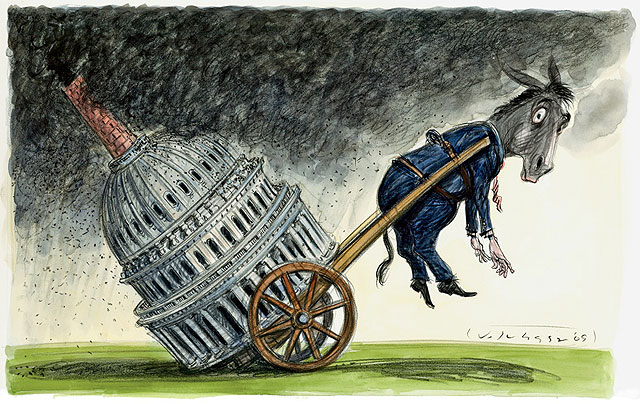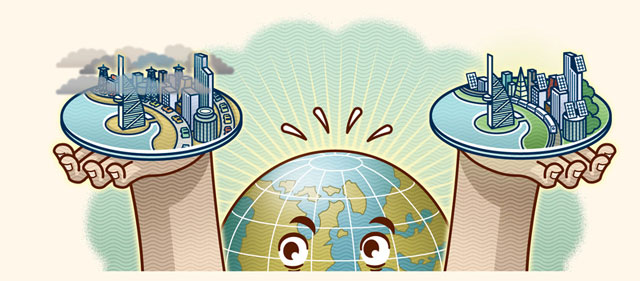sierraclub.org - sierra magazine - September/October 2009 - grapple


Grapple | With Issues and Ideas
Dude, Where's My Carbon Bill? | Up to Speed | La Guacamaya | Location, Location, Location
As the World Warms | Woe Is Us | Spoils of War | EPA's Most Wanted

Dude, Where's My Carbon Bill?
Coal-state Democrats threaten to scuttle clean-energy legislation
On inauguration day Barack Obama promised to "work tirelessly" to "roll back the specter of a warming planet." Unfortunately, some in Congress are working tirelessly in the opposite direction. Despite the president's still-high popularity rating and the Democrats' control of both houses, a strong climate-protection bill may not pass this year—thanks at least in part to Democratic representatives who cast their lot with dirty energy.
By the time the American Clean Energy and Security Act, sponsored by Representatives Ed Markey (D-Mass.) and Henry Waxman (D-Calif.), left its first committee, the bill's emission-reductions and renewable-energy targets had been scaled back dramatically at the behest of coal-state Democrats. They also finagled free carbon-pollution permits for utilities and would strip the EPA of its ability to regulate carbon emissions under the Clean Air Act. Agriculture Committee chair Collin Peterson (D-Minn.) won major concessions protecting the lucrative corn ethanol industry.
What's keeping Democrats from backing the tough climate bill Obama promoted on the campaign trail? Economists Matthew Kahn and Michael Cragg compared congressional-district demographics with representatives' voting records and reached the unsurprising conclusion that "poor, conservative, carbon-intensive [districts] are the least likely to vote to mitigate carbon," as Kahn says. The "Carbon Democrats" also happen to be very well represented on the committees that shape environmental legislation—likely because these committees shape energy legislation as well. Kahn and Cragg found that Democrats on the House Energy and Environment Subcommittee, for instance, represent districts whose per capita carbon emissions are 31 percent higher than those in the districts of the average congressional Democrat.
All eyes turn now to the Senate, which will take up the bill in September. The Environment and Public Works Committee, chaired by Barbara Boxer (D-Calif.), is expected to draft strong companion legislation that may remedy some weaknesses of the House version. But then it's on to the Senate floor, the graveyard of progressive legislation. What price will Carbon Democrats—and Carbon Republicans—exact to pass a bill to limit carbon? —Dashka Slater
La Guacamaya
Flocks of wild parrots, mostly conures, have colonized urban perches from San Francisco to Brooklyn. But only two species of parrot are native to the United States. One of these, the Carolina parakeet, is as expired as Monty Python's Norwegian blue. The other, the thick-billed parrot (left), disappeared from the United States in the 1920s, but small numbers still live in the wilds of northwestern Mexico. In his 1937 essay "The Thick-Billed Parrot of Chihuahua," Aldo Leopold described its "roistering" call as "full of the salty enthusiasm of high comedy."
The Arizona Game and Fish Department plans to reintroduce the parrot to the state, using birds captured in Mexico. But with fewer than 3,000 remaining, the Mexican population first needs to be stabilized. To that end, the American Bird Conservancy has worked with the Mexican group Pronatura Noreste to buy nearly 2,500 acres of old-growth nesting habitat at Mesa de las Guacamayas, where large pines were outfitted with nesting boxes. The first nesting pair has already moved in—a sign, perhaps, that the raucous laughter of the guacamaya will echo again throughout the Southwest. —P.R.
Location, Location, Location
When it comes to understanding climate change, there are lies, damn lies, and graphics. The map at left shows greenhouse-gas emissions per acre in the vicinity of Phoenix, Arizona. Unsurprisingly, pollution is concentrated in the metro area. But if you flip the perspective, as the Chicago-based nonprofit Center for Neighborhood Technology has done (map at right), and look at greenhouse gas produced per household, a different picture emerges: The suburbs, where residents often hop in the car and drive to get a bottle of milk, are the culprits, while the urban core is relatively benign.
In fact, CNT found that the "location efficiency" of living in a city can lower a household's transportation-related emissions by nearly 70 percent. Find out how your region measures up at cnt.org. —P.R.

AS THE WORLD WARMS:
Quick thinking before we slowly fry
Low-Carbon Spaceprint Virgin Galactic, an arm of Richard Branson's Virgin Group, plans to charge well-heeled space tourists $200,000 a head for a two-hour suborbital flight 62 miles above Earth. Company president Will Whitehorn says the flights will produce 60 percent less carbon dioxide per passenger than a New York-London round-trip flight, thanks to a carbon-composite rocket, high-altitude air launches, and a "benign hybrid" rocket motor. Killjoy critics still grump about sending "billionauts" on cosmic joyrides.
Echo Chamber The U.S. Chamber of Commerce's strong opposition to the Markey-Waxman climate-change bill is riling some of its members. In May, Johnson and Johnson asked chamber leaders to cool it unless their comments "reflect the full range of views, especially those of Chamber members advocating for congressional action." An analysis of the 122 companies on the chamber's board by the Natural Resources Defense Council found that 19 support greenhouse-gas regulation, 4 oppose, and the rest have no position.
Buzz Off The periodical cicadas of eastern North America are sometimes called "17-year locusts" because the juveniles live underground for 17 years before emerging en masse for a buggy bacchanal of feeding, mating, and egg laying. But in parts of the Midwest, cicadas are emerging four years early. Gene Kritsky, a biology professor at Ohio's College of Mount St. Joseph, says the phenomenon "might be another biological response to increasing temperatures." —D.S.

ON THE ONE HAND...
Per capita resource consumption in Dubai is the highest on Earth. A six-year building boom in the oil-rich emirate has fueled 13 percent annual growth in water and electricity use and a 30 percent increase in construction waste from 2000 to 2008. Dubai's luxury hotels are particularly wasteful, says local facilities-management firm Farnek Avireal: Five-star hospitality there consumes 225 percent more juice than the equivalent experience in Europe. Dubai's Palazzo Versace Hotel, slated to open next year, will feature a beach with artificially cooled sands, a refrigerated swimming pool, and giant fans that blow soft breezes over sunbathing guests.
ON THE OTHER...
Weary of its resource-wasting reputation, Dubai has also put its Godzilla-sized stamp on green building. Coming in 2012 are Food City, a 5-million-square-foot "off-the-grid, self-sufficient metropolis" that will incorporate solar energy, gray-water collection, and aquatic farms; and Xeritown, a 60-acre "sustainable city" that will offer public transit, gray-water reclamation, water-conscious landscaping, and shaded canopies for 7,000 residents. Both projects may be dwarfed by the Ziggurat, a proposed carbon-neutral pyramid that would house one million people on less than a square mile. —D.S.
Woe Is Us: Ready, set, panic.
 Acid Bath
Acid Bath
You know how in gangster movies the hitmen dispose of the bodies by dissolving them in acid? That's what we're doing to all sea life. Half of the 240 billion tons of carbon dioxide we've put into the atmosphere since 1800 has been absorbed by the world's oceans, increasing acidity by 30 percent and changing seawater to carbonic acid. In terms of pH (lower numbers equate to higher acidity), that means a drop of 0.1 from preindustrial levels to today's 8. If world CO2 trends continue, by the end of the century ocean pH will be 7.7.
At 7.8, however, shell formation ceases. Barnacles, sea snails, and corals will decline precipitously. Coral reefs will disintegrate. Many plankton will also be at risk because their bodies are built of calcium carbonate. As plankton go, so go krill; if krill go, there go the whales and the many other krill-eating species. This June, 70 world science academies, including the National Academy of Sciences, issued an urgent warning that unless we slash CO2 emissions, "we could be looking at fundamental and immutable changes" to marine life.
Big Hairy Spiders
Danish researchers in Greenland have found that global warming seems to be making the hairy, carnivorous wolf spider unnaturally large. A longer hunting season is to blame.
Tiny Woolly Sheep
Elsewhere in the North Atlantic, wild sheep on the Scottish island of Hirta are shrinking because winters are no longer harsh enough to kill off little lambs.
—P.R.
Spoils of War:
Who died for your cell phone?
Almost every consumer electronics product—including every cell phone—contains a small amount of a metallic ore called columbite-tantalite. The material is mined in Australia and Canada, but the richest deposits are found in prime gorilla habitat in the eastern portion of the Democratic Republic of Congo. The region has seen millions of people die in a brutal civil war over the past 15 years—with much of the conflict financed by the lucrative metal, known in the DRC as coltan.
After the United Nations released a report in 2001 on coltan's connection to the war, some electronics companies began requiring written verification that the cell phone capacitors they purchase "do not contain tantalum derived from illegally mined Congolese coltan," as Motorola puts it.
Nevertheless, says Robert Mwiniyhali, who works with the Wildlife Conservation Society in the DRC, "coltan extraction is still going on in some parts of the lowland sector of Kahuzi-Biega," a national park specifically set aside for eastern lowland gorillas—which are often killed to feed hungry miners. From there, Mwiniyhali says, the metal makes its way to a market in nearby Bukavu, where it is purchased and exported by various unsavory sorts, including companies and individuals cited by the U.N. and the U.S. Treasury Department as being involved in illegal arms trading.
Despite the verifications from some suppliers, electronics companies "cannot demonstrate that the coltan in their products isn't coming from protected areas," says Maurice Carney of the advocacy group Friends of the Congo. "Even before it leaves Congo, the exporters can't tell you whether or not it came from a rebel-held mine."
While the world awaits the first gorilla-safe (and conflict-free) cell phone, Advanced Micro Devices has unveiled its latest computer chip: the "Congo." —Paul Tullis
EPA's Most Wanted:
They can run, but they can't hide
 There are some scary eco-criminals out there, and not all of them are former members of the Bush administration. In charge of apprehending them is the Environmental Protection Agency's Criminal Enforcement division, whose special agents carry firearms, conduct investigations, and bust bad guys. And when defendants in environmental crimes go on the lam, their mug can end up on the EPA's version of the post office wall at epa.gov/fugitives.
There are some scary eco-criminals out there, and not all of them are former members of the Bush administration. In charge of apprehending them is the Environmental Protection Agency's Criminal Enforcement division, whose special agents carry firearms, conduct investigations, and bust bad guys. And when defendants in environmental crimes go on the lam, their mug can end up on the EPA's version of the post office wall at epa.gov/fugitives.
There you'll find eco-malefactors like Denis Feron (left), former owner of Chemetco, a large refiner of recycled copper. Turns out Chemetco had a secret pipe behind its facility that discharged toxic waste into a tributary of the Mississippi River. Feron fled the country before trial and is thought to be living in Belgium.
Then there's Mauro Valenzuela (center), a mechanic who illegally loaded chemical oxygen generators in the cargo compartment of ValuJet Flight 592 in 1996. They apparently caught fire, causing the plane to crash in the Everglades, killing all 110 on board. Valenzuela fled after arraignment and hasn't been seen since.
A tip from an online informant helped capture Larkin Baggett (right), owner and operator of a Utah hazardous-waste company that dumped waste down the sewer. Baggett skipped out pending trial but was rearrested this March in Florida.
If you happen to spot any of these characters at your local farmers' market, says EPA spokesperson Dave Ryan, you should report them to your local police and "not attempt to apprehend them on your own." —P.R.
Photos and illustrations, from top: Victor Juhasz, map courtesy of the Center for Neighborhood Technology, Peter and Maria Hoey (2), John Ueland